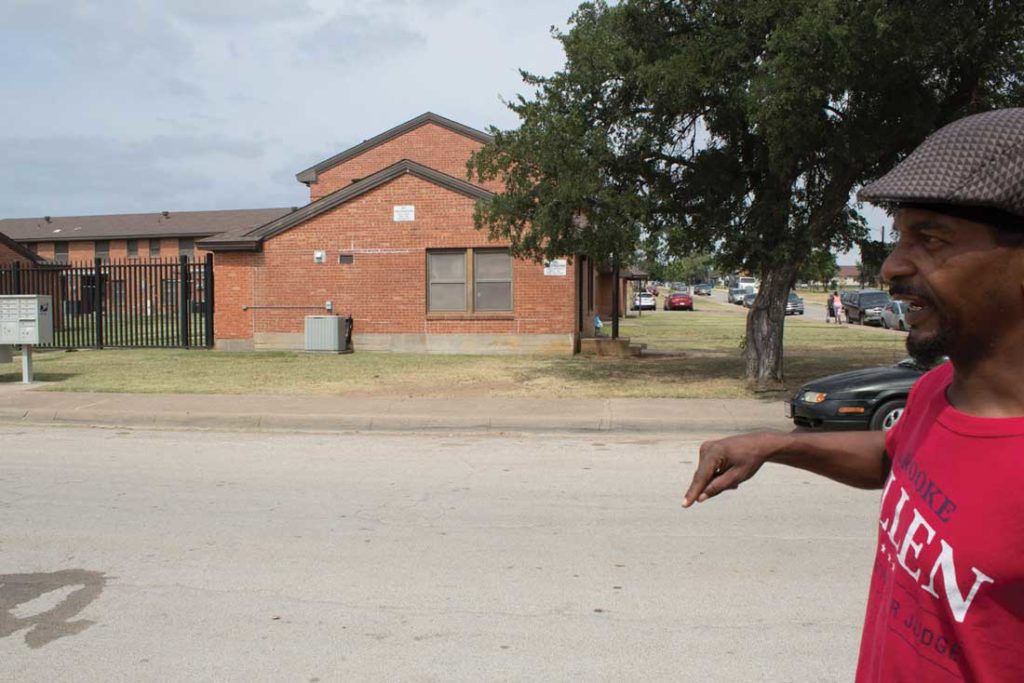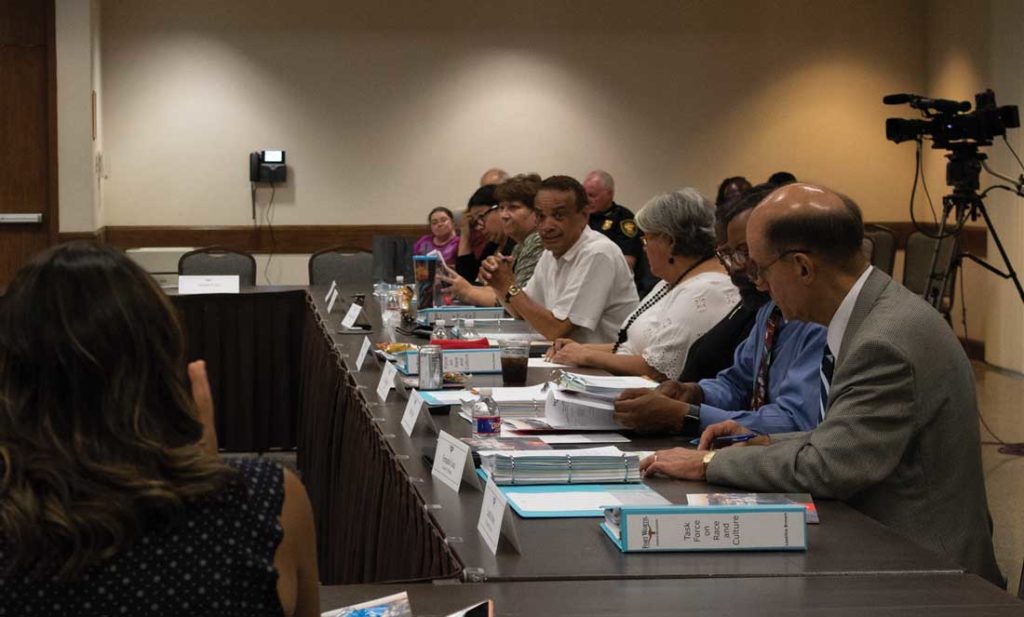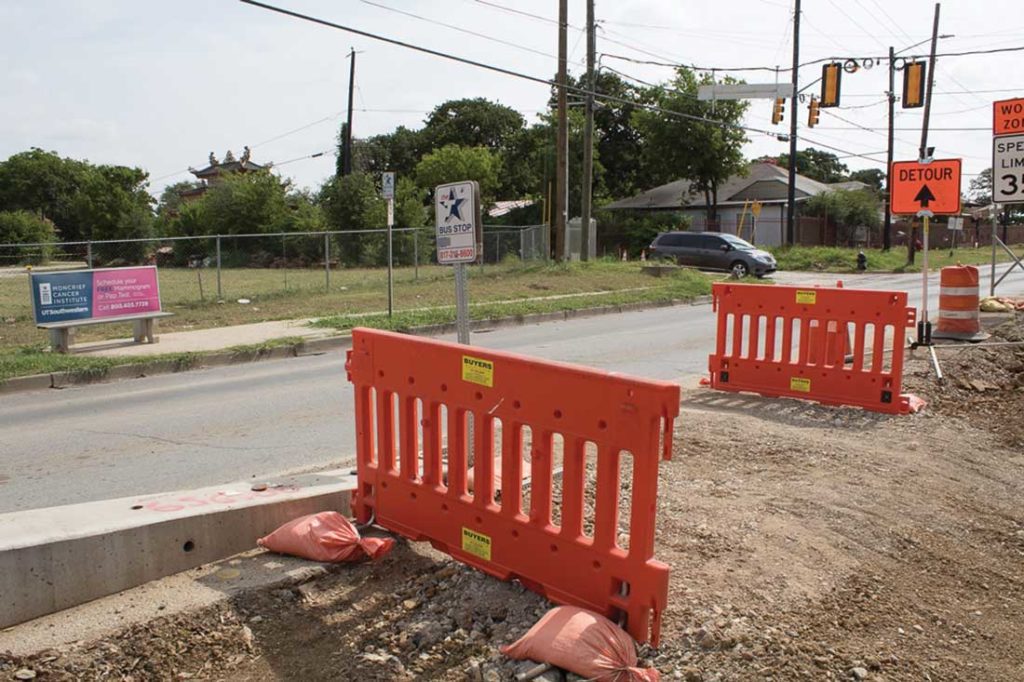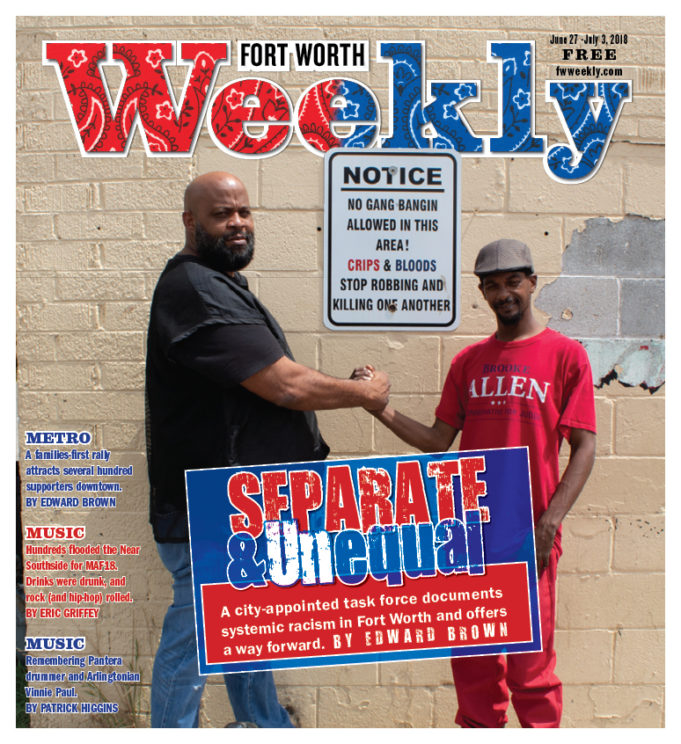An interim report commissioned by Fort Worth City Council puts the daily hardships of local poor black and Hispanic families into stark numbers.
Black residents, the report found, are disproportionately likely to be arrested in Fort Worth. African-Americans accounted for 41 percent of all arrests in 2016 and 2017, even though they represent only 19 percent of the city’s population. The report’s authors were repeatedly told by minority residents that police “unfairly target” their homes. The report also found that the top 14 most under-performing schools in the Fort Worth school district serve minority communities, and of an estimated 13,000 Fort Worth households listed as “substandard” by the city, meaning that they lack a complete kitchen or plumbing, 59 percent are occupied by Hispanic families, who also live near the most poor-condition roads (77 percent) and sidewalks (81 percent).
The reality of life for these families contrasts with the narrative espoused by Mayor Betsy Price, most city officials, and the city’s tourism and promotional wing, Visit Fort Worth. While city politicians are quick to boast about the 15th largest city in the United States as a tourist destination on the rise, an economy buoyed by a swelling population, and a “Cowboys and Culture” way of life, an increasing number of locals say they are being left behind.
The members of the year-old Race & Culture Task Force, who authored the report, presented some of their findings to city council at City Hall last May. Last week at the Fort Worth Botanic Garden, around a dozen local residents came for presentations on economic development. As part of a guest panel, Fort Worth economic development director Robert Sterns, Fort Worth Chamber of Commerce small business head Jarred Howard, and Visit Fort Worth president Robert Jameson talked about their respective efforts to spur development in town. The three guests acknowledged that growth and investment have not always reached poorer communities, especially in South Fort Worth.
“What will solve these disparities?” asked task force co-chairman, longtime Star-Telegram columnist, and civil rights advocate Bob Ray Sanders. “Any ideas? Tell us what we can bring to city council that will lead to change. Time is short.”
The formation of the task force was spurred by the violent arrest of a black mother, Jacqueline Craig, by a white Fort Worth police officer, William Martin, in late 2016. A video of the incident seemed to be yet another example of excessive force on the part of police toward an unarmed person of color. The video went viral, sparking dozens of protests and calls for Martin to be fired. He wasn’t.
The resisting-arrest charges filed against Craig were later dropped, and Martin was given a 10-day suspension. Craig and her supporters began voicing disgust with the legal system during city council meetings, even after Mayor Price publicly apologized to the Craig family –– while defending the police department’s decision to not fire Martin.
The Race & Culture Task Force was formed several months later to address the resultant public outrage. The four co-chairs –– Lillie Biggins, Rabbi Andrew Bloom, Rosa Navejar, and Sanders –– were asked to select 19 members. The task force’s goal: to consult with the community and draft recommendations to city council to “create an inclusive Fort Worth” for all residents, according to the city’s website.
Sanders told me in a phone interview that before he joined, he warned the mayor that the task force had better not be about “delaying tactics.”
He said other task force members felt the same way. “The mayor and city manager assured us they wanted to be presented with recommendations” that would lead to meaningful change, he said.
Over the next several months, the task force members spoke with several hundred Fort Worth residents and community leaders as well as local law enforcement officials and city staffers.
“One of the things that kept coming back to us [in comments] was that the city wasn’t trying hard enough” to improve race relations and economic opportunities for minorities, Sanders said. “Many of the people who talked to us felt that city leaders don’t care about these issues. They feel that no matter what we recommended, the city will do nothing about it.”
At City Hall in May, the task force asked for and was granted an extension to continue work through the end of 2018.
Following the presentation, Councilmember Kelly Gray, who is African-American, described the preceding year of community conversations as “eye-opening” and “heart-wrenching.”
The other black councilmember, Gyna Bivens, thanked the task force and offered some advice.
“One thing that bothers me is that we do things the way we do them because that’s the way we do them,” she said. “When you see us getting to the ledge [with implementing the task force’s recommendations] and not willing to jump — push.”
Sanders said that many of the black and Hispanic residents he’s spoken with remain cynical about the prospects for change. Having grown up in a poverty-stricken Fort Worth neighborhood, he said he has seen the city’s spending priorities firsthand. Read the report at Onefortworth.org.
“The majority of the city’s bond money doesn’t go to southeast Fort Worth,” he said. “We’ve thrown pennies at those neighborhoods over the years. Certain communities are forgotten and neglected.”
*****

Subsistence living is a way of life for many in Stop Six, a mostly black neighborhood in southeast Fort Worth. The area suffers from an unemployment rate two-and-a-half times higher than the city average, according to Fort Worth data. Nearly 80 percent of the population is categorized as “low to moderate income,” and the neighborhood has some of the highest crime rates in Fort Worth.
Longtime residents Roger Foggle and Charleston White gave me a tour of the neighborhood where they grew up, pointing to living conditions that would surprise most folks living on the west side of I-35. As we walked through active construction along East Rosedale Street, White pointed to several temporary bus stops. Uneven dirt and gravel paths, frequently traversed by heavy earthmovers, were the only access points to the stops.
East Rosedale Street, between Miller Avenue and Loop 820, is getting a facelift with the help of funds from the Texas Department of Transportation (TxDOT), a Fort Worth bond, and the federal government. According to the city’s website, the project consists of a “concrete four-lane divided boulevard with sidewalks, street lights, and intersection improvements.”
The expanded lanes and increased traffic will generate new business growth along East Rosedale, said Councilmember Bivens, whose district encompasses Stop Six.
Foggle and White aren’t so sure.
A small metal sign posted near two concrete barriers reads, “Bus Stop.”
“City officials said this is acceptable,” White said, referring to emails that he obtained through open records requests and that he shared with me.
In one email, Bivens said the bus stops are a “non-issue.”
Bivens told me in a phone interview that she shares the concerns of locals using the temporary stops, but due to the partnership with TxDOT, the city is not in complete control of all aspects of the ongoing construction.
“Progress and construction are always inconvenient,” she said. “I’ll be glad when it’s over. I think you’ll see people are quite pleased with the changes.”
White worries about the handicapped and elderly residents who rely on the stops.
“This is an active construction site,” he said. “You have pedestrians with no protections. You got cars flying down and kicking up rocks here.”
White showed me several videos on his phone of fast-moving cars passing only inches away from elderly black residents sitting on the same concrete barriers near where White and I were standing. As we continued down the construction site, we passed several pedestrians who were walking between moving bulldozers and large holes in the ground.
Until school recently let out, Foggle said, many students were left with no option but to cross the bombed-out conditions on foot to reach Jacquet Middle School or Paul Laurence Dunbar High School, both to the south.
From what I witnessed, no efforts have been made to separate pedestrians from the ongoing construction. Indeed, the bus stops, nestled between partially completed Rosedale to the north and dug-up roads to the south, remain invitations for serious injury. Or worse.
The Americans with Disabilities Act applies to bus stops, according to the U.S. Department of Transportation. City spokesperson Kevin Neal said the Transportation and Public Works Department is “aware of the bus stop accessibility issues along the construction area of Rosedale Street.”
He said the transportation department is working with TxDOT and the bus line, Trinity Metro (formerly The T), to improve access to those stops within the next few weeks.
White said these safety conditions would never be acceptable in Arlington Heights, Westover Hills, or some other predominantly white, predominantly upper-middle-class neighborhood. Local elected officials, business leaders, and the media don’t pay enough attention to the plight of Fort Worth’s poor communities, he said.
As Dallas-based chains take root in developments like The Shops at Clearfork, Waterside, and WestBend, the only new businesses coming to Stop Six are dollar stores, pawnshops, and check-cashing businesses. Heavily armed police gang units operate frequently in the area, White said, randomly stopping young black men for questioning.
Dilapidated homes and shuttered buildings define much of Stop Six. With few job prospects in the area, White said, prostitution and selling drugs are the only options many teenagers have for work. Foggle and White said the city should invest in parks and job-training programs in the area while providing summer activities to keep youths out of trouble. Foggle and White also would like to see more elected officials show up to speak with the residents of Stop Six.
Fort Worth City Council recently awarded Stop Six a $2.56 million grant as part of a pilot program called the Neighborhood Improvement Strategy. The goal, according to the city, is to “reduce the number of felony incidents, enhance pedestrian safety, improve residents’ perception of their community, improve neighborhood aesthetics, and leverage additional public and private investment.”
The program has already hauled off tons of trash and added sidewalks, Bivens said.
But White doesn’t believe improvement will come soon enough.
“Visually, this is depressing,” White said as we drove past the cratered land near East Rosedale Street. “There are no flowers or pretty structures [in Stop Six]. This has to be psychologically depressing for a child. Where does hope come from when you wake up, and all you have to play with are rocks and a hole in the ground.”
*****

To understand the mistrust within Fort Worth’s minority communities toward their elected officials and law enforcement requires acknowledging the long history of local and state policies that gave economic advantages to white residents while conferring disadvantages on everyone else, said TCU professor of history Max Krochmal.
“If the city of Fort Worth wants to tackle racial inequality, that history matters,” he said. Fort Worth City Council “can’t treat this like it’s a problem that started yesterday. They can’t act as if it’s just some misunderstanding.”
The professor and author of Blue Texas: The Making of a Multiracial Democratic Coalition in the Civil Rights Era said the racial strife that has erupted in recent years — the Black Lives Matter movement, mass protests, riots in Ferguson, Missouri — is due in part to the unfulfilled goals of the civil rights movement of the late 1950s and 1960s.
“It was a real revolution,” he said. “I don’t want to diminish that. The opening of public spaces [to minorities], ending segregation, and passage of the Civil Rights Act were [real achievements], but they were only Step 1 as the activists saw it.”
After researching and interviewing dozens of civil rights era activists, Krochmal documented a trend. The civic leaders described a common goal — one that began with liberation and ended with access to political power and economic justice.
“They were interested in meaningfully altering the future,” he said. “They weren’t able to do a lot of those things.”
What the leaders of that movement were up against, Krochmal said, was friction from white Americans who held the economic purse strings then as they do now.
“White America was willing to deal with integration as a problem that belonged to someone else,” Krochmal said. “For [progressive] Northerners, their kids’ schools weren’t facing integration, for the most part. Even white liberals decided the rights had gone too far [by the mid-1960s]. It pushed up against their privilege. If you attended a suburban school district, to have a school that’s better, you have to have a school that’s worse. The system is based on inequity. If you want to achieve equity, you need to reduce privilege while uplifting the disadvantaged. I don’t think we’re ready to deal with that today, and we certainly weren’t ready in the 1960s.”
Fort Worth embraced segregation, as most of the South did, as a way to politically disenfranchise and economically marginalize freed slaves in the decades following the Civil War. While lynchings and poll taxes are remembered as blatant acts of racism throughout the South, more subtle public policy initiatives were every bit as oppressive toward minorities. Until the passage of the Fair Housing Act in 1968 –– which protected homebuyers and renters from discrimination based on race, color, religion, or national origin –– many Southern states drafted and upheld laws that denied the rights of blacks and certain minorities to live in areas zoned for whites.
The Federal Housing Administration, formed in 1934 to encourage homeownership throughout the United States by providing government-backed mortgage insurance, further divided neighborhoods along racial lines through its policy of not insuring mortgages near black communities.
“This agency took discriminatory practices and made them the law of the land,” Krochmal said. “Housing was later subsidized for white veterans under the G.I. bill” following World War II.
When housing and zoning policies failed to keep Hispanic and black families out, white residents in Fort Worth often resorted to mob violence, Krochmal said, referring to years of documented hate crimes perpetrated locally from 1920 through the ’50s.
“Many [black] families had crosses burned on their lawns in Fort Worth’s South Side,” he said. “We interviewed a gentleman, Lloyd Austin, who moved into the Riverside area only to witness mob assemble to keep him from moving in. Across North Texas, there were house bombings in the 1940s and 1950s with an earlier wave in the 1920s. Realtors often refused to show houses [in white neighborhoods] to African-Americans and Hispanics. If you could get in, [minorities] could expect violence, an artificially expensive home, and less favorable [loan] terms. And the second you moved in, the value of your house dropped by virtue of the color of your skin.”
Employment discrimination, subsequently backed by massive wartime government contracts, continued into the early- to mid-1940s, Krochmal said. The aerospace company Convair (later bought by General Dynamics) was tasked with building B-24 bombers and other aircrafts for the war overseas. Thousands of white men and women heeded the call to work on the assembly lines, giving Fort Worth its largest middle class yet — a prosperous group of white workers who subsequently moved into homogenous neighborhoods.
Lesser known today, Krochmal added, is the similar mistreatment of Hispanic men and women during and before the civil rights movement under what historians refer to as “Juan Crow.”
The recent decision to not join an ongoing lawsuit against SB 4, the controversial state bill that allows peace officers to question the immigration status of a person they lawfully detain, demonstrates how divided our city remains, Krochmal said.
Last August, dozens of concerned, largely Hispanic residents spoke in favor of Fort Worth’s joining every other major Texas city in the lawsuit to rule SB 4 unconstitutional. The final 5-4 vote, with four white councilmembers and the white mayor voting against one Hispanic and two black councilmembers, highlighted why many in the minority community continue to mistrust elected officials, Krochmal said.
“The [public] input was overwhelmingly in support of joining the lawsuit,” Krochmal recalled, referring to presentations made to city council that evening. “Instead of taking those stories seriously, they discounted it — a classic Southern plantation approach. They were effectively saying, ‘We who are least affected by these problems have a better sense of what the answer is than you who are most affected by them.’ ”
The task force members, he added, appear to be sincerely fulling their mission.
“It’s a good start for this city,” he said. “The real question is what is going to happen when it goes back to city council.”
*****

Fort Worth’s city leaders are taking a multifaceted approach to transforming the way they approach racism and inequality, said Angela Rush, Fort Worth human relations administrator. In conjunction with the task force efforts, high-level city staff (including the mayor, city manager, and city councilmembers) recently completed three full-day training sessions led by staffers from the advocacy group the National League of Cities, a member-based resource for cities.
The Race, Equity, and Leadership sessions were developed four years ago by the National League of Cities in the wake of unrest in Ferguson, Missouri, following the fatal shooting of an 18-year-old unarmed black man by a white police officer.
“We looked at the history of institutional and structural racism in America because it’s important to know how we got to where we are,” Rush said. City staffers “looked at racial disparities using statistical data and discussed white privilege. Racial equality is one of the biggest predictors of a city’s success.”
Discrimination is not only damaging to society. It’s expensive. Racial inequity resulted in $135.38 billion in lost GDP across North Texas in 2015, according to the National League of Cities. Leading factors for the lost revenue included low pay resulting from hiring discrimination and lack of access to education in minority communities.
Estrus Tucker, a longtime resident of the historically black Fort Worth neighborhood Como and a public speaker, is spearheading the city’s efforts to discuss race relations through public conversations. Held at public spaces throughout the city every few weeks, the meetings focus on “healing the wounds of the past,” Rush said.
“The audiences have been very diverse,” Rush said. “White privilege is never easy to discuss. To have white people saying, ‘This makes us uncomfortable, but let’s talk about it’ has been eye-opening.”
Earlier this year, 1,600 Fort Worth police officers completed training in Integrating Communications, Assessment, and Tactics De-escalation, a program by the nonprofit Police Executive Research Forum which teaches peace officers how to respond to explosive situations without resorting to using deadly force.
“It was a criminal justice issue that got us here,” Sanders said, referring to public uproar that resulted from the arrest of Craig and her daughters. “I think there will be some profound recommendations that our city needs to deal with.”
Sanders pointed to an ongoing effort in Austin to independently redraw city council districts through an Independent Citizens Redistricting Commission as one way forward. The 14-member commission is structured to be free of influence from elected officials and is tasked with redrawing districts based on public input each year following the national census. Fort Worth is expected to add two city councilmembers in the first election after the 2020 census.
“We know the current city council does not represent Fort Worth,” Sanders said, referring to the city’s minority-majority status. African-American and Hispanic communities constitute 54 percent of Fort Worth’s overall population.
“With two additional seats, what will that say if we don’t come up with more minority representation. I think city council is happy with what they have right now. They would likely try to preserve their own districts. We understand that. There may be some [recommendations] that are dead on arrival. I told the task force that it’s not our job to decide what may or may not be dead on arrival. I am open to bold ideas coming out of these committees that will be seen by the community as something they want. I want to have something presented to city council that the city’s residents will find worth fighting for. It’s going to be a test.”
Bivens said her focus throughout this process remains on economic development and equity. In the past, she said, Fort Worth gave economic incentives through tax cuts to businesses willing to move here but without the expectation of higher salaries. She admits that many of those incentives have gone to affluent areas in the past.
“There should be more incentives for those who need it,” she said. “If you don’t have some idea of fairness when deciding who wins, this city will have people not sharing in progress. I appreciate the work the National League of Cities and the task force has done, but I question if my city will be bold enough to make changes for the sake of equity.”
In an email, Mayor Price told me that the task force’s interim report made it clear to her that the city “must do better.”
She said she is “committed to working with the task force as they present recommendations for positive change. While racial and cultural disparities are never easy to discuss and are often uncomfortable, it is very important to the future of our city. In order for Fort Worth to continue to grow, we must learn to have tolerance and to celebrate our differences.”
Krochmal said Fort Worth needs to allocate funds for racial equity work.
“There should be special pots of money put aside for addressing these systemic issues,” he said. “That’s one way any organization can signal they are serious about the work.”
Krochmal points to the Racial and Ethnic Equity Policy passed by Fort Worth school district trustees early last year as another step Fort Worth City Council could take to ease racial tensions. The policy aims to end institutional racism, stating that “any achievement gap between white students and students of color … is unacceptable.”
The mayor and city council should be doing “everything they can to increase civic engagement and voter participation,” he added. “I think for too long, this city has been OK with not having civic engagement. It’s not enough to engage entrepreneurs or chambers of commerce. We need to find new ways to highlight the voice of the communities that have long been marginalized.”
Sanders said he doesn’t want to preempt any recommendations under consideration from the task force’s various committees. He hopes a series of recommendations for city council will be ready by August, so the task force can hear community feedback before final recommendations are presented to city council this December. He personally would like to see the recommendations focus on criminal justice and economic development in poor neighborhoods.
If Fort Worth wants to be a modern, progressive city that attracts businesses, it needs to begin addressing the issues of economic inequality and lack of access to public transit, Sanders said.
“When we talk about attracting larger companies, those companies are looking for places where diversity is present and diversity works,” he said. “They don’t want to move somewhere that’s talking about disparities that go back 40 years. They are looking for communities that are solving these problems. The fact that we’re still talking about some of these issues is ridiculous to me. As one who [grew up] during the Jim Crow days, the days of segregation, I thought that by this stage of my life, I’d see such great change that I wouldn’t be talking about them right now. In some areas, we have regressed. It concerns me. I now know I will die with there being a great racial divide, not only in my city but in my country.”













I get it. All ya’ll who depend on buses just need to stop living until the progress and construction are completed. Easy peasy right? Whyever can’t progress be planned better to minimize the inconvenience of businesses going out of business because of road construction; vehicle overheating, catching on fire and humans health jeopardized and minimized while they wait in hours long traffic nightmares? All this for the blow ins coming from across the country while the residents are minimized and marginalized. Sure I’m not the only one with diminished quality of life in the past eight years and it keeps on getting worse.
Question for Charleston White: Do you call Code Compliance when weeds get too high in your neighborhood, or when loose dogs run around? Or are you too afraid of your neighbors to do this, or maybe just too lazy. Always easier to blame it on downtown.
I actually cut it myself by paying the neighborhood kids to do it
Spare us the “disparate treatment” cr@p. There is far more at play than “systemic racism,” there is also the virulent racism of the minority communities, who don’t recognize any duty to obey the laws of “the man.” Read the well-documented pieces by Colin Flaherty, author of such illuminating, though politically incorrect, books as White Girl Bleed a Lot: The Return of Racial Violence and How the Media Ignore It. This nihilistic world view is rife in the black communities, and unaddressed by the media and those who foster it. THAT is the reason behind the higher arrest and incarceration rates among “people of color.” Thanks, LBJ’s “Great Society.”
And before anyone casts aspersions at me of being ignorant of this city commission, I attended one of the public forums. It was nothing but a self-congratulating, virtue signaling “gimme” fest. What a waste of taxpayer money.
Fix your own communities, one household at a time.
If you begin with the assumption that a variance between treatment of different demographic groups proves the existence of prejudice, then you must accept the proposition that our criminal justice system’s much harsher treatment of males proves preferential treatment of females. Now, liberals who posit the variance-proves-bias argument with regard to race, don’t want to accept that females are given preferential treatment, so they’ll argue that males display a disproportionate share of criminality — Which is true — but their willingness to discount the variance-proves-bias argument as between the sexes but not between races proves their hypocrisy. This is why liberals are losing.